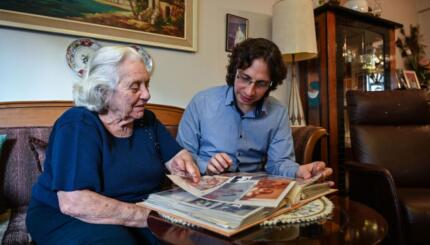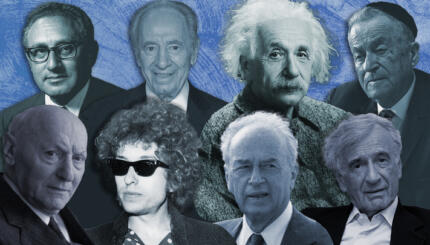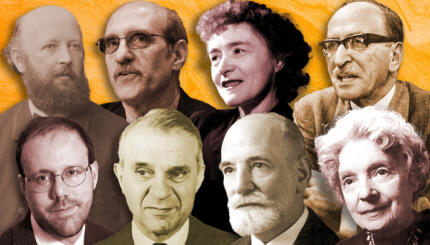As the following article describes, issues of landscape dominate the development of Israeli art. But even when it comes to Israeli landscape-focused artwork, questions of politics and identity tend to be the true subjects; landscapes are intertwined with issues of possessing the land and developing and asserting a national identity through the land. This inclusion of politics in art often leads to tensions and controversies. Reprinted with permission from the Israeli Ministry of Foreign Affairs.
From the beginning of the 20th century, visual arts in Israel have shown a creative orientation influenced by the encounter between East and West, as well as by the Land itself and its development, the character of the cities and stylistic trends emanating from art centers abroad. In painting, sculpture, photography, and other art forms, the country’s varied landscape is the protagonist: the hill terraces and ridges produce special dynamics of line and shape; the foothills of the Negev, the prevailing grayish-green vegetation and the clear luminous light result in distinctive color effects; and the sea and sand affect surfaces.
On the whole, local landscapes, concerns, and politics as well as the very nature of Israeli existentialism lie at the center of Israeli art and ensure its uniqueness.
Encouraging the Study of Art
Organized art activity in the country began in 1906, the year Professor Boris Schatz (1867-1932) arrived from Bulgaria and founded the Bezalel Academy of Arts and Crafts in Jerusalem, according to a plan approved at the 1905 Zionist Congress to encourage talented young Jews to study art in the Land of Israel. By 1910, the school had 32 different departments, a student body of 500, and a ready market for its works throughout the Jewish world.
With your help, My Jewish Learning can provide endless opportunities for learning, connection and discovery.
In addition to painters and sculptors, the country’s artistic life comprises a host of talented craftspeople (ceramicists, silver and goldsmiths, weavers, calligraphers, glass blowers, etc.), many of whom specialize in modern interpretations of traditional Jewish ceremonial objects.

|
A painting by Nahum Gutman.
|
Enthusiasm for art prevails among people from all walks of life, as Israelis encourage and support art activities by attending exhibits–from one-artist retrospectives to comprehensive group shows at the country’s many museums and private galleries–by frequenting the artists’ quarters of Safed and Yafo [Jaffa] or the artists’ village of Ein Hod, and by purchasing the works of local artists.
At the outset, Bezalel’s artistic orientation, which aimed at creating an “original Jewish art” by fusing European techniques with Middle Eastern influences, resulted in paintings of biblical scenes depicting romanticized perceptions of the past linked to utopian visions of the future, with images drawn from the ancient Jewish Eastern communities as well as from the local Bedouin. Artists of this period include Shmuel Hirszenberg (1865-1908), Ephraim Lilien (1874-1925), and Abel Pann (1883-1963).
‘Hebrew’ vs. ‘Jewish’ Art
The first major art exhibition (1921), held at David’s Citadel in Jerusalem’s Old City, was dominated by painters from Bezalel. Soon afterward, however, Bezalel’s anachronistic, national-oriental narrative style was challenged both by young rebels within the Bezalel establishment and newly-arrived artists, who began searching for an idiom appropriate to what they termed “Hebrew'”–as opposed to “Jewish”–art.
In an attempt to define their new cultural identity and express their view of the country as a source of national renewal, they depicted the daily reality of the Middle Eastern environment, with emphasis on the bright light and glowing colors of the landscape, and stressed exotic subject matter, such as the simple Arab lifestyle through a predominantly primitive technique, as seen in the works of painters including Israel Paldi, Tziona Tagger, Pinhas Litvinovsky, Nahum Gutman, and Reuven Rubin. By the middle of the decade, most of the leading artists were established in the new, dynamic city of Tel Aviv (est. 1909), which has remained the center of the country’s artistic activity.
The art of the 1930s was strongly influenced by early 20th century Western innovations, the most powerful of which was the expressionism emanating from the ateliers of Paris. Works of painters such as Moshe Castel, Menachem Shemi, and Arie Aroch tended to portray an emotionally charged, often mystical reality through their use of distortion and, although themes still dealt with local landscapes and images, the narrative components of 10 years earlier gradually disappeared and the oriental-Muslim world vanished entirely.
German expressionism was introduced in the middle of the decade with the arrival of immigrant artists fleeing the terror of rising Nazism. Joining German-born artists Anna Ticho and Leopold Krakauer, who had come to Jerusalem some 20 years earlier, this group–which included Hermann Struck, Mordechai Ardon and Jakob Steinhardt–devoted itself largely to subjective interpretations of the landscape of Jerusalem and the surrounding hills. These artists made a significant contribution to the development of local art, notably through the leadership given to the Bezalel Academy of Art by its directors, Ardon and Steinhardt, under whose guidance a new generation of artists grew to maturity.
The Impact of the Holocaust
The break with Paris during World War II and the trauma of the Holocaust caused several artists, including Moshe Castel, Yitzhak Danziger, and Aharon Kahana, to adopt the emerging “Canaanite” ideology, which sought to identify with the original inhabitants of the land and create a “new Hebrew people” by reviving ancient myths and pagan motifs.
The 1948 War of Independence led other artists, including Naftali Bezem and Avraham Ofek, to adopt a militant style with a clear social message. But the most significant group formed in this period was “New Horizons,” which aimed to free Israeli painting from its local character and literary associations and bring it into the sphere of contemporary European art.
Two major trends developed: Yosef Zaritzky, the group’s dominant figure, tended toward an atmospheric lyricism, characterized by the presence of identifiable fragments of local landscape and cool color tones. His style was adopted by others, notably Avigdor Stematsky and Yehezkel Streichman. The second trend–a stylized abstractionism ranging from geometricism to a formalism frequently based on symbols–was strongly evident in the works of the Romanian-born artist Marcel Janco, who studied in Paris and was one of the founders of Dadaism. The New Horizons group not only legitimized abstract art in Israel but was also its dominant force up to the early 1960s.
Artists of the 1960s provided the connecting link between the activities of the New Horizons group and the search for individuality in the next decade. Streichman and Stematsky, both teachers at the Avni Institute in Tel Aviv, strongly influenced a second generation of artists, including Raffi Lavi, Aviva Uri, Uri Lifschitz and Lea Nikel who, in their search for a personal imagery, challenged the refined brushwork of lyrical abstractionism with pluralistic works, encompassing various expressive and figurative abstract styles derived from sources abroad.
At Bezalel, Ardon’s influence, especially with regard to themes and techniques, evidenced itself in the works of Avigdor Arikha, who developed a world of forms filled with intense spiritual meaning, and in the return to figurative themes evocative of the Holocaust and traditional Jewish subjects, as seen in the surrealistic paintings of Yossl Bergner and Samuel Bak. Jacob Agam is a pioneer in optic and kinetic art, and his work is exhibited in many countries.
While the minimalism characteristic of art in the 1970s almost always included amorphic, transparent forms reminiscent of local abstract painting, the exposition of ideas rather than aesthetics dominated the works of artists such as Larry Abramson and Moshe Gershuni. The artists of the 1980s and 1990s, working in an atmosphere of individual experimentation, appear to be searching for content and a sense of Israel’s spirit by integrating a wide range of materials and techniques, as well as images based on local and universal elements as diverse as the letters of the Hebrew alphabet and the human emotions of stress and fear.
Current trends, as in the work of Pinhas Cohen-Gan, Deganit Beresht, Gabi Klasmer, Tsibi Geva, Tzvi Goldstein, David Reeb and others, continue to strive toward broadening the definition of Israeli art beyond its traditional concepts and materials, both as the unique expression of an indigenous culture and as a dynamic component of contemporary Western art.
Sculpture Flourishes
The art of sculpture flourished in the country due to the efforts of a few sculptors over a long period of time. While Avraham Melnikoff (known for his massive stone lion at Tel Hai), and Ze’ev Ben-Zvi introduced cubism, the more academic school of sculpture, represented by Moshe Ziffer, Aharon Priver, and Batya Lishansky, dominated the field prior to the establishment of the state.
At the end of the 1940s, the “Canaanite” ideology influenced a number of artists, notably Yitzhak Danziger, whose figure of the pagan hero-hunter Nimrod, carved from red Nubian sandstone, is an attempt to create a synthesis between Middle Eastern sculpture and the modern concept of the human body, while the forms comprising his sculpture of sheep resemble those of desert rocks, water canals and Bedouin tents. Sculpture in the 1950s employed new materials and monumental scale as it became increasingly abstract, stimulated in part by the recent introduction of iron and corten steel as a sculptural medium.
The desire to provide a tangible memorial to those who fell in Israel’s wars gave sculpture a new impetus from the 1960s on, and a great many monuments, primarily nonfigurative, were introduced into the Israeli landscape. This genre is represented by Yehiel Shemi’s welded steel naval memorial at Achziv, which deals both with the harshness of nature and the human capacity for violence and destruction, and Dani Karavan’s “Monument to the Negev Brigade” outside Be’er Sheva, evoking the special character of desert combat. [At the same time, it should be noted that Israel has generally shied away from the level of memorial art one may expect from a war-torn country. Perhaps, though, the relative paucity of memorial art is a consequence of the abundance of tragedies that the country has faced; otherwise, it would seem as if memorials fill every street corner.]
Under the influence of the French school in general and expressionism in particular, and utilizing a wide range of materials, contemporary conceptual artists are creating installations and environmental sculptures to depict their individual reactions to social and political realities. Incorporating a powerful play of shapes and symbols, the works of Yigal Tumarkin express his protest against war through geometric and figurative abstract forms, while the trend towards geometric minimalism is especially pronounced in Menashe Kadishman’s persistent use of the images of sheep, which call up both a local pastoral image and a personal myth symbolizing the helpless victim.
Aharon
Pronounced: ah-ha-RONE, Origin: Hebrew, Aaron in the Torah, brother of Moses.
Avraham
Pronounced: AHVR-rah-ham, Origin: Hebrew, Abraham in the Torah, considered the first Jew.
Moshe
Pronounced: moe-SHEH, Origin: Hebrew, Moses, whom God chooses to lead the Jews out of Egypt.
Yitzhak
Pronounced: eetz-KHAHK, Origin: Hebrew, Hebrew name for Isaac.


